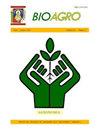Influence of arbuscular mycorrhizal fungi on biological control of coffee leaf rust (Hemileia vastatrix BERK. & BROOME)
IF 0.7
4区 农林科学
Q4 AGRONOMY
引用次数: 1
Abstract
Inoculating plants with arbuscular mycorrhizal fungi (AMF) protects host plants against biotic stressors such as diseases. Therefore, the objective of this study was to evaluate the influence of arbuscular mycorrhizal fungi in the biological control of coffee leaf rust (CLR) infections. The research involved two varieties of coffee (Caturra and Pache) and three inocula of AMF: Moyobamba (Acaulospora mellea, Acaulospora sp.1, Glomus geosporum, Glomus sp.1, and Glomus sp.2), El Dorado (Acaulospora rugosa, Acaulospora spinosissima, Acaulospora lacunosa, Glomus sinuosum and Ambispora appendicula) and Huallaga (Acaulospora mellea, Acaulospora sp.1, Acaulospora sp.2, Glomus macrocarpum and Glomus sp.2), in addition to a control treatment without application of AMF (non-AMF). Inoculation of vegetatively propagated coffee plants with AMF was observed to induce tolerance to CLR. The incidence of CLR in non-AMF coffee plants was 43.7 %, while in the coffee plants subjected to the inocula Moyobamba, El Dorado and Huallaga, the incidences were 22.1, 22.7 and 13.2 %, respectively. Likewise, the severity in non-AMF coffee plants was 34.8 %, while in the coffee plants subjected to the three kinds of inocula, the severities were 21.1, 20.4 and 12.0 %, respectively. Thus, mycorrhizal inoculation of coffee plants at the nursery stage reduces the negative effect of CLR infection after the plants are taken to field conditions, representing a sustainable option for their biological control.丛枝菌根真菌对咖啡叶锈病生物防治的影响。&布鲁姆)
用丛枝菌根真菌(AMF)接种植物可以保护寄主植物免受生物胁迫,如疾病。因此,本研究的目的是评价丛枝菌根真菌在咖啡叶锈病(CLR)生物防治中的作用。该研究涉及两种咖啡品种(卡图拉和帕切)和三种AMF接种剂:Moyobamba (Acaulospora mellea, Acaulospora sp.1, Glomus geosporum, Glomus sp.1和Glomus sp.2), El Dorado (Acaulospora rugosa, Acaulospora spinossima, Acaulospora lacunosa, Glomus sinusum和Ambispora appendicula)和Huallaga (Acaulospora mellea, Acaulospora sp.1, Acaulospora sp.2, Glomus macrocarpum和Glomus sp.2),此外还有不施用AMF的对照处理(非AMF)。用AMF接种无性繁殖的咖啡植株可诱导对CLR的耐受性。非amf咖啡植株的CLR发病率为43.7%,而接种过Moyobamba、El Dorado和Huallaga的咖啡植株的CLR发病率分别为22.1%、22.7%和13.2%。同样,非amf咖啡树的严重程度为34.8%,而接种三种疫苗的咖啡树的严重程度分别为21.1%、20.4%和12.0%。因此,在苗期接种菌根可以减少咖啡植株在田间条件下CLR感染的负面影响,是一种可持续的生物防治选择。
本文章由计算机程序翻译,如有差异,请以英文原文为准。
求助全文
约1分钟内获得全文
求助全文
来源期刊

Bioagro
Agricultural and Biological Sciences-General Agricultural and Biological Sciences
CiteScore
1.40
自引率
37.50%
发文量
22
期刊介绍:
Bioagro es una revista científica del Decanato de Agronomía de la Universidad Centroccidental “Lisandro Alvarado” (UCLA). Su periodicidad es cuatrimestral y se publica en los meses de enero, mayo y septiembre. Cada trabajo es revisado por al menos dos especialistas en el área, externos a la revista, de cuya opinión depende la aceptación definitiva. Se utiliza sistema de arbitraje doble ciego.
La revista va dirigida, fundamental pero no exclusivamente, a profesionales y técnicos del área agrícola. Su objetivo es publicar trabajos científicos originales e inéditos en ciencias agrícolas que enfoquen aspectos de agronomía, botánica y propagación de plantas, entomología y zoología, suelos, fitopatología y protección vegetal, ingeniería agrícola, genética y mejoramiento de plantas, ecología, procesamiento de productos agrícolas, biotecnología y sociales. También pueden ser publicados artículos cortos en los que se presenten descubrimientos científicos, desarrollos tecnológicos y resultados de diagnósticos integrales, en la modalidad de Notas Técnicas.
En Venezuela, se encuentra en las bibliotecas de todas las universidades e institutos de educación superior que ofrecen carreras agronómicas, así como de los entes oficiales de investigación agropecuaria. En el exterior, la revista llega a universidades y/o institutos de investigación agrícolas de todos los países de América Latina así como Estados Unidos, Canadá y España.
 求助内容:
求助内容: 应助结果提醒方式:
应助结果提醒方式:


